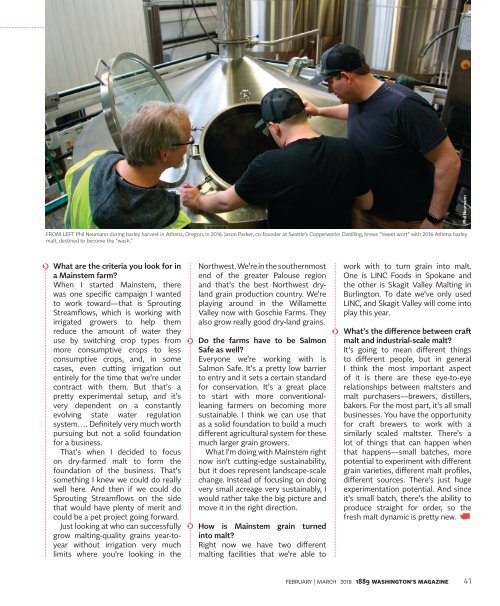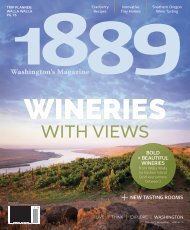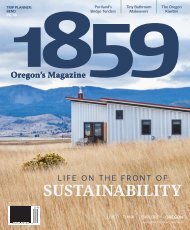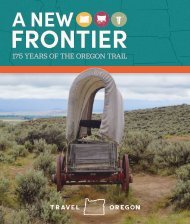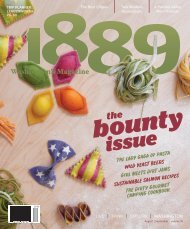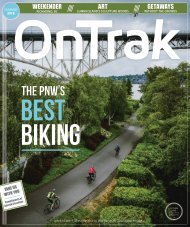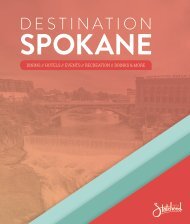Create successful ePaper yourself
Turn your PDF publications into a flip-book with our unique Google optimized e-Paper software.
what i’m working on<br />
Phil Neumann<br />
FROM LEFT Phil Neumann during barley harvest in Athena, Oregon, in 2016. Jason Parker, co-founder at Seattle’s Copperworks Distilling, brews “sweet wort” with 2016 Athena barley<br />
malt, destined to become the “wash.”<br />
What are the criteria you look for in<br />
a Mainstem farm?<br />
When I started Mainstem, there<br />
was one specific campaign I wanted<br />
to work toward—that is Sprouting<br />
Streamflows, which is working with<br />
irrigated growers to help them<br />
reduce the amount of water they<br />
use by switching crop types from<br />
more consumptive crops to less<br />
consumptive crops, and, in some<br />
cases, even cutting irrigation out<br />
entirely for the time that we’re under<br />
contract with them. But that’s a<br />
pretty experimental setup, and it’s<br />
very dependent on a constantly<br />
evolving state water regulation<br />
system. … Definitely very much worth<br />
pursuing but not a solid foundation<br />
for a business.<br />
That’s when I decided to focus<br />
on dry-farmed malt to form the<br />
foundation of the business. That’s<br />
something I knew we could do really<br />
well here. And then if we could do<br />
Sprouting Streamflows on the side<br />
that would have plenty of merit and<br />
could be a pet project going forward.<br />
Just looking at who can successfully<br />
grow malting-quality grains year-toyear<br />
without irrigation very much<br />
limits where you’re looking in the<br />
Northwest. We’re in the southernmost<br />
end of the greater Palouse region<br />
and that’s the best Northwest dryland<br />
grain production country. We’re<br />
playing around in the Willamette<br />
Valley now with Goschie Farms. They<br />
also grow really good dry-land grains.<br />
Do the farms have to be Salmon<br />
Safe as well?<br />
Everyone we’re working with is<br />
Salmon Safe. It’s a pretty low barrier<br />
to entry and it sets a certain standard<br />
for conservation. It’s a great place<br />
to start with more conventionalleaning<br />
farmers on becoming more<br />
sustainable. I think we can use that<br />
as a solid foundation to build a much<br />
different agricultural system for these<br />
much larger grain growers.<br />
What I’m doing with Mainstem right<br />
now isn’t cutting-edge sustainability,<br />
but it does represent landscape-scale<br />
change. Instead of focusing on doing<br />
very small acreage very sustainably, I<br />
would rather take the big picture and<br />
move it in the right direction.<br />
How is Mainstem grain turned<br />
into malt?<br />
Right now we have two different<br />
malting facilities that we’re able to<br />
work with to turn grain into malt.<br />
One is LINC Foods in Spokane and<br />
the other is Skagit Valley Malting in<br />
Burlington. To date we’ve only used<br />
LINC, and Skagit Valley will come into<br />
play this year.<br />
What’s the difference between craft<br />
malt and industrial-scale malt?<br />
It’s going to mean different things<br />
to different people, but in general<br />
I think the most important aspect<br />
of it is there are these eye-to-eye<br />
relationships between maltsters and<br />
malt purchasers—brewers, distillers,<br />
bakers. For the most part, it’s all small<br />
businesses. You have the opportunity<br />
for craft brewers to work with a<br />
similarly scaled maltster. There’s a<br />
lot of things that can happen when<br />
that happens—small batches, more<br />
potential to experiment with different<br />
grain varieties, different malt profiles,<br />
different sources. There’s just huge<br />
experimentation potential. And since<br />
it’s small batch, there’s the ability to<br />
produce straight for order, so the<br />
fresh malt dynamic is pretty new.<br />
FEBRUARY | MARCH <strong>2018</strong> <strong>1889</strong> WASHINGTON’S MAGAZINE 41


